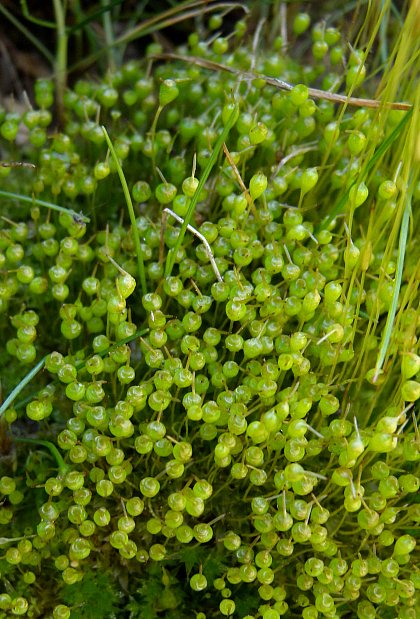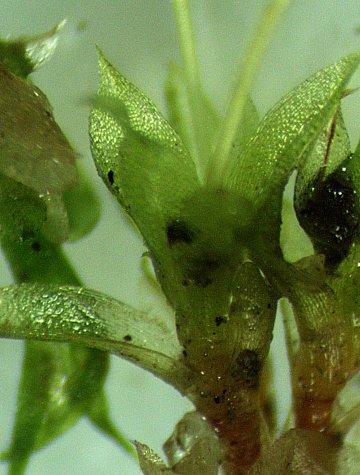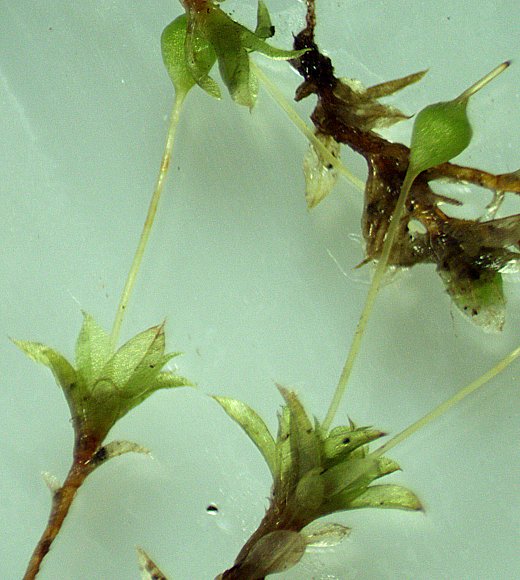
The stalk is 5-15 mm. long, light green to red (depending on its maturity and exposure to sunlight), terete, and smooth. Including its lid (operculum), the spore-bearing capsule is 2-3 mm. long, obpyriform-rhombic or obpyriform-globoid in shape (like an upside-down angular or rounded pear), hairless, and light green while immature. The lid of the capsule is convex with a short narrow beak in the middle; it is initially covered with a membranous hood that has a long narrow beak. As the capsule matures, the protective hood falls off and the lid falls off to release the spores of the capsule to the wind; this usually happens during the spring. At this time, the lidless capsule has a cup-like or urn-like shape with a rolled upper rim. This upper rim lacks teeth (no peristome). The mature lidless capsule is often yellowish brown or red. Individual spores are relatively large in size for a moss (45-60 microns), globoid in shape, and finely warty-prickly. The root system of the moss consists of fibrous rhizoids. This moss occurs in colonies and as scattered individual plants.
Cultivation: The preference is full sun to light shade, moist conditions, cool temperatures, and either ground soil or rocks with a thin layer of dirt or humus. This moss is relatively indifferent to soil type, as it occurs on loam, clay, sand, or gravel. The life cycle of this ephemeral moss extends from fall to spring. It can complete its development in as little as 3 months (Nakosteen, 1978).

Range & Habitat: Goblet Moss is common in the NE, central, and SE sections of Illinois, while in the NW and SW sections of the state it has been collected less often (see Distribution Map). Because mosses are undercollected, it may occur in every county of the state. Goblet Moss is widely distributed in North America, Europe, and other parts of the world. Habitats include ground soil in deciduous woods, stream banks in wooded areas, disturbed ground along rivers, exposed garden soil, exposed soil along fences, exposed soil near parking lots, exposed ground under powerline clearances, fallow fields, pastures, roadside embankments, campground sites, wet disturbed sand along ponds, cavities of limestone rocks, limestone ledges along rivers, cracks of concrete dams, and waste areas. Goblet Moss is a pioneer species that colonizes disturbed areas with exposed ground.
Faunal Associations: A study in Poland has found Goblet Moss (Physcomitrium pyriforme) growing on the faeces of the European Bison (Bison bonasus) and Tarpana Horse (Equus gmellini). This raises the possibility that the spores of this moss can pass through the digestive tracts of some animals and remain viable, thereby spreading this moss into new areas. However, it is also possible that this moss colonized the faeces as a result of the wind-distribution of its spores (Jaroszewicz et al., 2011).

Photographic Location: A colony of this moss was found on a north-facing wall of cloth bags containing soil in Urbana, Illinois.
Comments: This is one of the first mosses to produce spore-bearing capsules during the spring. When the distinctive spore-capsules are present, it is relatively easy to identify. While there are other Physcomitrium spp. in Illinois with a similar appearance, they are uncommon within the state. One of them, Physcomitrium immersum, has not been collected within the state since 1900, while the other species, Physcomitrium hookeri, can be distinguished by its smaller size and leaves that are always toothless. All of these species seem to prefer similar disturbed habitats.